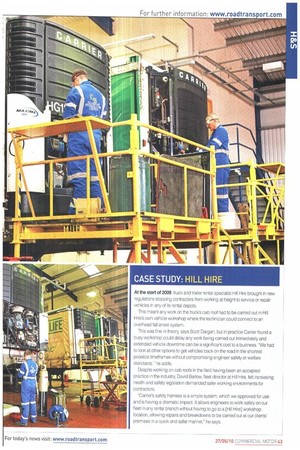CASE STUDY: HILL HIRE
Page 43

If you've noticed an error in this article please click here to report it so we can fix it.
At the start of 2009, trucK and trailer rental specialist Hill Hire brought in new regulations stopping contractors from working at height to service or repair vehicles in any of its rental depots.
This meant any work on the truck's cab roof had to be carried out in Hill Hire's own vehicle workshop where the technician could connect to an overhead fall arrest system.
This was fine in theory, says Scott Dargan, but in practice Carrier found a busy workshop could delay any work being carried out immediately and extended vehicle downtime can be a significant cost to a business. "We had to look at other options to get vehicles back on the road in the shortest possible timeframes without compromising engineer safety or welfare standards," he adds.
Despite working on cab roofs in the field having been an accepted practice in the industry, David Barlow, fleet director at Hill Hire, felt increasing health and safety legislation demanded safer working environments for contractors.
"Carrier's safety harness is a simple system, which we approved for use and is having a dramatic impact. It allows engineers to work safely on our fleet in any rental branch without having to go to a [Hill Hire] workshop location, allowing repairs and breakdowns to be carried out at our clients' premises in a quick and safer manner," he says.
































































































































